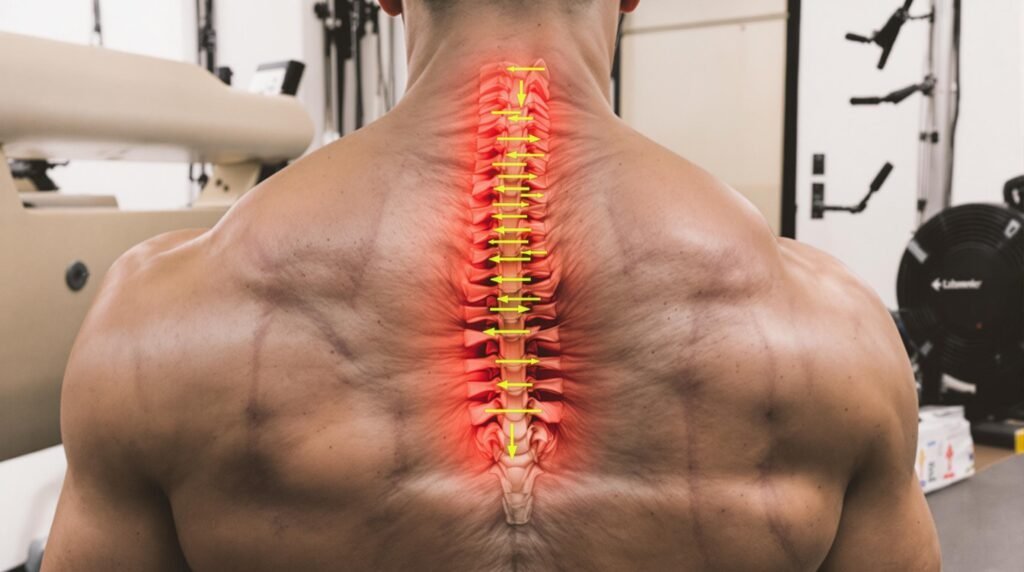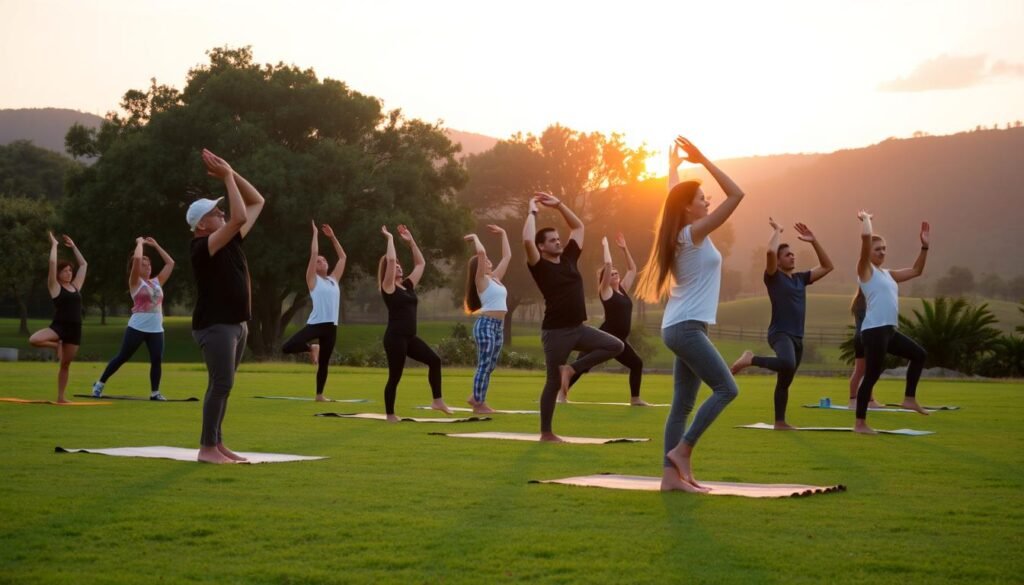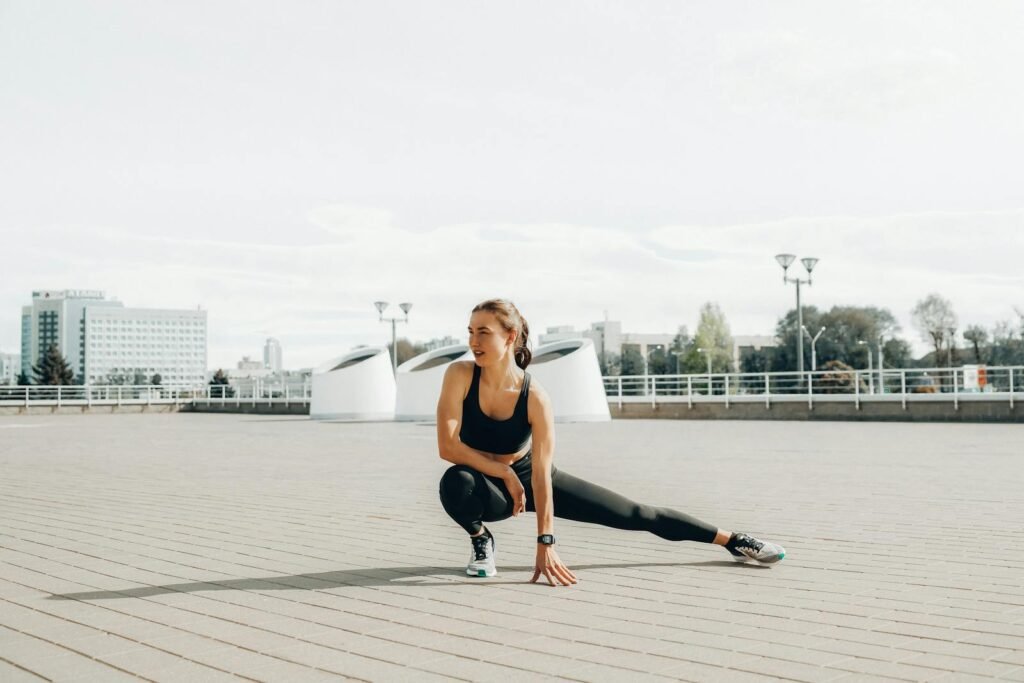Did you know that adding flexibility exercises to your cardio routine can boost your heart health? It also cuts down injury risks by 27%. A study found that mixing flexibility training with cardio lowers injury rates. Flexibility is key to staying fit and avoiding injuries.
Key Takeaways
- Flexibility exercises can enhance cardiovascular performance by improving range of motion and blood circulation.
- Targeted flexibility training helps prevent common injuries associated with cardio activities, such as sprains, strains, and joint pain.
- Integrating dynamic stretching routines into your pre-workout warm-up is essential for physical safety and injury prevention.
- Flexibility assessment and progressive development are key to maximizing the benefits of combined cardio and flexibility training.
- Incorporating active recovery techniques and joint mobility exercises can further optimize your fitness results.
Understanding the Connection Between Flexibility and Cardiovascular Health
Starting your fitness journey? It’s key to know how flexibility and heart health are linked. Better flexibility boosts your muscle strengthening and joint protection. It also helps your cardio performance a lot.
The Science Behind Flexibility and Heart Health
Many studies show that more flexibility means better body mechanics education and posture alignment. This makes your heart work less hard. It reduces strain and boosts your heart’s function.
How Improved Range of Motion Affects Cardio Performance
Being more flexible means your joints move better. This makes your movements during cardio exercises more efficient. You can do exercises with better form, lowering injury risk and boosting your performance.
Benefits of Combined Flexibility and Cardio Training
- Increased endurance and stamina
- Improved oxygen uptake and utilization
- Enhanced muscle coordination and balance
- Reduced risk of injury and better recovery
Adding flexibility training to your cardio routine improves your fitness. It also makes your heart healthier and more resilient.
Essential Dynamic Stretching Routines for Pre-Cardio Preparation
Getting your body ready for a cardio workout is key to doing your best and staying safe. Dynamic stretching routines are a must, as they warm up your muscles and boost your flexibility. Adding these exercises to your pre-cardio routine helps you perform better and lowers injury risks.
Here are some top dynamic stretching routines to try before your cardio session:
- Arm Circles: Stand with your feet shoulder-width apart. Then, swing your arms in small circles, first forward and then backward. Do this for 20-30 seconds to warm up your shoulders and upper body.
- Leg Swings: Stand with one hand on a wall or chair for balance. Swing your leg forward and backward, keeping it controlled and your core tight. Do 10-15 reps on each leg.
- Torso Twists: Stand with your feet shoulder-width apart. Slowly twist your torso from side to side, keeping your hips facing forward. Repeat for 20-30 seconds to loosen your spine and improve rotation.
- Hip Circles: Stand with your feet hip-width apart. Slowly circle your hips in one direction, then the other. This stretch targets your hips, glutes, and lower back.
It’s important to keep your movements smooth and controlled when doing dynamic stretches. By adding these routines to your warm-up, you’ll boost your flexibility, enhance your cardio performance, and reduce injury risks.
“Dynamic stretching prepares the body for the demands of cardiovascular exercise, allowing you to move with greater ease and efficiency.”
Prevent Injuries, Physical Safety Priority, Flexibility Focus Body
Keeping your body safe is key when doing cardio exercises. Focus on injury prevention and safety to make your workouts effective and safe. Here are tips to keep your body safe and flexible while exercising.
Key Areas for Injury Prevention
Knees, ankles, hips, and lower back are common injury spots during cardio. Improving flexibility and stability in these areas can lower injury risks. Adding injury prevention exercises to your routine is vital for protecting your body.
Safety Protocols During Exercise
Using the right form and technique is critical for safety protocols during workouts. Follow ergonomic guidelines like good posture and even weight distribution. Also, start slowly and increase intensity and time to avoid injuries.
Flexibility Assessment Guidelines
Checking your flexibility regularly helps spot issues and guide prevention. Use tests like the sit-and-reach or shoulder mobility to check your range. This info helps you focus on specific stretches to improve flexibility.
| Key Areas for Injury Prevention | Recommended Flexibility Exercises |
|---|---|
| Knees | Quadriceps stretches, hamstring stretches, calf raises |
| Ankles | Ankle rotations, plantar fascia stretches, Achilles tendon stretches |
| Hips | Hip flexor stretches, glute bridges, lateral lunges |
| Lower Back | Cat-cow poses, trunk rotations, lower back extensions |
By focusing on injury prevention exercises, following physical safety protocols, and checking your flexibility often, you can make a safe and effective fitness plan. This plan will help you avoid injuries and get the most from your workouts.
Core Stabilization and Its Role in Injury Prevention
Core stabilization is key for top cardio performance and injury prevention. Your core muscles, around your torso, are vital. They provide the body conditioning and muscle balance needed for intense exercises.
A strong core is the base for all movements. It keeps your body aligned during cardio. Engaging your core muscles boosts your core stabilization. This improves balance, coordination, and control during workouts.
- Stronger core muscles reduce joint and muscle strain. This lowers the risk of sprains, strains, and other injuries from cardio.
- Good core stability helps keep proper form and technique. This ensures safe and effective exercise performance.
- A conditioned core supports and powers high-intensity activities. It lets you reach your limits without harming your body.
Adding core stabilization exercises to your warm-up and cool-down can greatly benefit your fitness. By focusing on core stabilization, you’ll enhance your cardio and protect your body from common injuries.
“A strong core is the foundation for all movement and the key to preventing injuries during high-intensity cardio workouts.”
Investing in core stabilization exercises is wise for anyone serious about fitness. It maximizes cardio benefits while reducing injury risks. By focusing on this critical fitness aspect, you’ll reach your full fitness goals and enjoy a healthier, more active life.
Integrating Flexibility Training into Your Cardio Routine
Adding flexibility exercises to your cardio routine boosts your fitness and prevents injuries. Knowing when and how to increase your flexibility training is key. This unlocks the full benefits of a well-rounded exercise routine.
Timing Your Stretches for Maximum Benefit
When it comes to flexibility, timing is everything. Do dynamic stretches before your cardio workout. This gets your body ready and increases your range of motion. You’ll be able to do cardio better.
After your workout, do static stretches to help recover. This keeps your body flexible and follows ergonomic best practices.
Progressive Flexibility Development
Increasing the challenge of your stretches is important for getting better. Begin with simple stretches and move to more advanced ones. This targets specific muscles and joints.
This gradual increase helps your body adapt. It supports your flexibility training and fitness goals.
Monitoring Your Progress
Check your flexibility progress regularly. You can measure your range of motion or how easily you stretch. Getting help from a fitness expert is also a good idea.
Tracking your progress keeps you motivated. It also shows where you need to focus more on your flexibility and ergonomics.
“Flexibility is the foundation for all physical activity. Invest in it, and you’ll reap the rewards in your overall fitness and performance.”
Joint Mobility Exercises for Enhanced Performance
Keeping your joints mobile is key to getting the most out of cardio workouts. Better joint mobility means you can move more efficiently, lower injury risks, and perform better in sports. Let’s dive into some exercises that can boost your workout.
Ankle Mobility Drills
Flexible ankles are essential for good form in running, cycling, and jumping. Here are some exercises to help:
- Ankle circles: Rotate your ankles in both clockwise and counterclockwise directions.
- Heel-to-toe walks: Slowly walk forward, lifting your heels and then your toes with each step.
- Wall ankle mobilizations: Face a wall, place your toes against it, and gently lean forward to stretch the ankles.
Hip Rotational Movements
Working on hip mobility can increase power and efficiency in lower-body exercises. Add these hip-focused drills to your routine:
- Leg swings: Swing your leg forward and backward, keeping your core engaged.
- Clamshells: Lie on your side with your knees bent, and lift your top knee while keeping your feet together.
- Perform quadruple hip circles by positioning yourself on all fours and slowly rotating your hips in both directions.
Thoracic Spine Mobility
Improving thoracic spine mobility can enhance your upper-body range of motion. This leads to better form and technique in exercises like push-ups and rowing. Try these movements:
- Thread the needle: Reach your arm under and across your body, rotating your torso as you go.
- Seated twists: Sit up straight, then slowly twist your upper body to the left and right.
- Foam roller thoracic extensions: Lie back on a foam roller and gently arch your upper back over the roller.
Regularly practicing these exercises can unlock your cardio fullness, improve form, and lower injury risks. Add them to your warm-up or cool-down for the best results.

Recovery Techniques and Active Stretching Methods
After a tough cardio workout, it’s key to focus on recovery to avoid injuries and boost your performance. Using active recovery and specific stretching can help your body recover fast. This gets you ready for your next workout.
Post-Workout Flexibility Protocols
It’s vital to do flexibility exercises after working out to keep your joints and muscles healthy. Start with dynamic stretches to stretch the muscles used in your cardio. This reduces muscle tension and boosts your range of motion, speeding up recovery.
Active Recovery Strategies
- Low-intensity activities like walking or light cycling help with active recovery. They increase blood flow and nutrients to tired muscles.
- Foam rolling and self-myofascial release can ease muscle soreness and improve flexibility.
- Wearing slip-resistant footwear during recovery activities makes you safer and more stable, lowering accident risks.
Rehabilitation Exercises
If you’ve hurt yourself from cardio, like with runner’s knee or Achilles tendinitis, special exercises can help. Work with a physical therapist or certified trainer to create a plan that meets your needs. This helps you get back to full activity safely.
A good recovery plan includes flexibility, active recovery, and specific rehabilitation exercises. This way, you can recover stronger and lower injury risks. Taking care of your recovery is as important as your cardio training.
Common Mistakes to Avoid in Flexibility Training
Flexibility training is key to a good fitness routine. But it’s easy to make mistakes that can hurt your progress or cause injury. As you start your flexibility journey, watch out for these common mistakes to get the best from your stretching and mobility exercises.
One big mistake is hazard identification. Many people don’t check their current flexibility levels before starting. This can lead to muscle strains and joint pain. Always start slow and gradually increase the intensity of your stretches.
Another mistake is not using job rotation strategies. Focusing too much on some muscles can lead to imbalances and injuries. Make sure to stretch and move all major muscle groups and joints.
Lastly, many forget the importance of protective equipment guidelines. Wearing the right clothes and using tools like foam rollers can help a lot. Invest in good, breathable clothes and consider using tools to improve your stretching.
By avoiding these mistakes, you can get the most out of flexibility training. Remember, flexibility is a journey, not a goal. Be patient, listen to your body, and adjust as needed.

“The key to successful flexibility training is to approach it with a balance of diligence and caution.”
| Common Flexibility Training Mistakes | Strategies to Avoid Them |
|---|---|
| Hazard Identification | Assess your current flexibility levels and gradually increase intensity. |
| Job Rotation Strategies | Incorporate a variety of stretches and mobility exercises to target all muscle groups. |
| Protective Equipment Guidelines | Invest in proper attire and supportive gear to enhance your stretching routine. |
Conclusion
Incorporating flexibility exercises into your cardio routine can greatly improve your wellness and athletic performance. Understanding the science behind flexibility and cardiovascular health is key. This knowledge helps you enjoy a better range of motion, prevent injuries, and optimize muscle function.
Dynamic stretching, core stabilization, and joint mobility exercises are vital. They protect your body during intense cardio and boost endurance and efficiency. By focusing on wellness initiatives, ergonomic practices, and muscle imbalance corrections, you’ll enhance your fitness journey.
Flexibility is a must for a well-rounded fitness routine. Follow the advice in this article and make flexibility training a key part of your cardio workouts. This will help you reach new heights, lower injury risks, and achieve your fitness goals.




